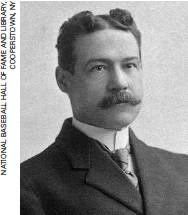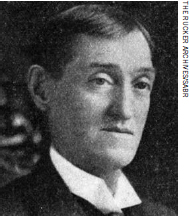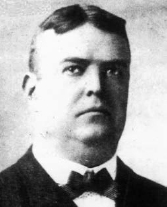Nineteenth-Century Battles Over the Draft
This article was written by Bob Bailey
This article was published in The National Pastime: Major Research on the Minor Leagues (2022)
There was once a time when Major League Baseball did not completely control all the players in the minor leagues. It was a time before farm systems and a time before the major leagues could pull players from a minor-league pennant race to supplement a major-league bench at will. It was a time before the major league teams could draft minor league players during the Winter Meetings.
But that was a long time ago.
The initial adoption of player draft language appears well over 130 years ago, in the 1891 National Agreement. The National Agreement was a contract between various baseball leagues, detailing their cooperation regarding contracts, territories, and rules, among other things.
With the demise of the Players League after the 1890 season, a new National Agreement was developed. Included in the document was Article 7 (I), “Purchasing Players’ Releases.” It said that if your league signed the National Agreement and agreed to the draft, any other signatory to the agreement in a higher classification could approach any of your team’s players, negotiate a contract (while the playing season was in progress), and snatch them off your roster for a set fee.1
When the 1891 season started, whenever a National League club would seek to grab a player, the sporting press would label it a draft.2 Denoting it a “draft” made it out as exactly what it appeared to be: a way for major league teams to fill in-season roster holes without the bothersome task of negotiating a market price with a given player’s team.
We don’t know who proposed this idea, although it is not hard to imagine a major-league owner looking for a way to lower the purchase price of a minor- league player. We also don’t know what the majors were paying for minor-league players, but based on very limited data, it appears that a rate of $1,500 was common. And with the majors looking for a bargain, the fee set by the National Board was $1,000 for a player from a Class A league.
Tracing the idea of a draft yields the first mention of the concept in 1887. This was a proposal by Francis Richter, editor of the Sporting Life, called the Millennium Plan.3
Richter was, in the main, a man who sought to make baseball a permanent part of the American sporting scene. As initially described by Richter, the plan was designed to help stabilize the minor leagues and stanch major league practices that caused leagues to lose clubs and ultimately to shut down.4 The details of the plan were published in December 1887.
Francis Richter introduced the concept of the draft in 1887. (National Baseball Hall of Fame Library)
In his preamble to the completed plan, Richter analyzes the financial situation of the majors and concludes that only about three clubs consistently earn a profit each season, with the rest struggling to cover expenses except for a rare competitive season. His view of the minors was more dire in that he saw very few clubs earning enough to generate any return on their investment. This caused ownership to frequently change in the minors and in non-competitive major league aggregations. This in turn, in Richter’s view, caused the quality of ownership to decline. On this point Richter saw profitable clubs as the path to owners who were not “speculators, gamblers, fly-by-night managers, and irresponsible people…”5
The Millennium Plan had many provisions and included a major-league draft of minor-league players. Richter’s draft proposal would have allowed the majors to claim minor leaguers for a set fee after the close of the season. This would be the only method to bring a player to the majors. The specific fee does not appear in the document but Richter sees it as “a small expense.” The trade-off for the reduced draft monies would be the minor leagues gaining a seat on the Board of Arbitration, the executive decisionmakers under the National Agreement. This proposal would clearly be a non-starter for minor league clubs as offseason sales of players at market rates was one of the few ways clubs had to balance the books most seasons.6
While the Millennium Plan went nowhere, the idea of the draft showed up in the 1891 National Agreement. There is no certain candidate for fatherhood at the major-league level but one candidate is Brooklyn owner Charles Byrne. Back in 1887, Byrne had floated an idea of reassigning players to new teams each year to create a more competitive pennant race. Byrne was an innovative owner for the period and was always involved with league management.7 Richter’s candidates were Chicago magnates Albert Spalding and A.G. Mills, who drafted the 1891 document along with Byrne.8
When the draft went into effect in 1891, it was a bit of a bust. We can identify eight draft attempts during the 1891 season with only four of them being successful. Often the draft foundered on the requirement that the player agree to switch teams and several did not wish to move.9
The minor leagues were bothered by the draft process (they were always bothered by the draft process). In particular they disliked the idea of losing a player during the season, and they also wanted more money. The majors, having not reaped much advantage from the current draft system, agreed to move the draft to the October-to-January period but left the fees the same.
John T. Brush owned both a National League team and a Western League team, and drafted four of his own players. (SABR-Rucker Archive)
The draft grew slowly from that point, totaling 14 picks in 1892 and 13 picks in 1893, many of which were never completed. The majors finally figured out how to use the draft to their advantage, and the counts double in 1894 and 1895 to 32 and 70 respectively.10 The trick was to not draft for the current year’s roster needs alone but to also draft to control as many promising players as you could afford. Since there were limitations on the size of major league rosters, the majors would retain contracts of excess players for use on reserve squads. By the mid-1890s someone developed the idea of lending players to the minor leagues. This evolved into the practice of option agreements. The major league club would agree to assign the contract of an excess player to the minor league club for one season. Within this agreement the major league club retained the right to recall the player to the big-league club with minimal notice, while passing along all other obligations (including salary payment) to the minor league club.
The minors, unsurprisingly, came to resent option contracts. Since the minors also had roster limitations, they were essentially turning over roster slots to the majors, thus limiting the minor league club’s flexibility to use their roster for their own benefit, since the rights to the optioned player reverted to the big-league club at the end of the season. Although many in the minors, and some of the press, abhorred option agreements, many minor league clubs did like filling roster holes with players provided by the majors. Such an arrangement with a big-league club lessened the need for the hiring of scouts or paying for a birddog to dig up new talent or purchasing players from other clubs. This differing attitude toward optioned players would arise again after World War I.
We can see here the ancient beginning of a farm club relationship as the majors flirted with the concept in the 1890s. The first major practitioner was John T. Brush, owner of the NL Cincinnati team in the 1890s. In 1894 Brush acquired the Western League’s Indianapolis franchise in addition to his Cincinnati ownership. Over the course of the next three drafts, Brush selected 13 players for his Cincinnati club. All 13 were from Western League clubs; four from his Indianapolis club to prevent other major league clubs from raiding his minor league club and the rest from other Western League clubs. In the next several seasons, he also moved these players between the Cincinnati and Indianapolis rosters as injuries occurred or improving minor league players earned a spot on the major league roster.11
Brush’s confreres in the Western League were not happy to lose players to an in-league rival. They were particularly rankled when Indianapolis rose from sixth place in 1894 to pennant-winner in 1895. Particularly exercised was Western League President Ban Johnson. The enmity between the two that started in Cincinnati when Johnson was a reporter for the Cincinnati Commercial-Gazette continued in the Western League and certainly contributed to Brush’s hostile attitude toward the American League and his ultimate refusal to play Johnson’s AL champs in a 1904 World Series.
Ban Johnson was not enamored of the way the Western League was treated by the National League, but his solution was to turn the Western League into a major league—the American League. (SABR-Rucker Archive)
Brush’s actions did not go unnoticed by other major league owners. Various clubs developed arrangements, generally under the table, to use specific minor league clubs to stash unneeded players in the minors as a strategy to develop untested players.12
The minor leagues would denounce option agreements loudly and continually into the 1930s. But options worked for the National League, the only major league at the time. They held onto control of an increasing number of players, thus avoiding paying more substantial prices for players who were ready for a place on a major league roster. Such players could also be a revenue source as the majors could sell players they determined had little major league potential back to the growing number of minor league clubs.
By 1896 the draft had run enough years that the various entities involved knew what they liked and didn’t like about the process. As you would expect, virtually all the issues, at their core, were economic ones. The major league liked that they had a source of new players at a price less than what an open market might command. They were also well-pleased with the ability to retain control of players beyond the initial draft year through option agreements. The minors had several things that disturbed them about the draft. They didn’t mind that the draft allowed them to pluck players from lower minor league classifications for a set price. But they called for several changes to the way the majors could claim players from the minors.
Changes were made in the 1896 National Agreement. The major added an explicit rule allowing big-league clubs to option players in the 1896 National Agreement. They called it Assignment of Undeveloped Players. The new language did not usher in the use of option agreements, but merely ratified an existing practice.13
In 1896, the major also cut the draft prices in half. In a move claiming to offset this change, they also cut the price for protection of contracts in half. This meant that each Class A minor league club would save $75 for the coming season while the majors saved $500 for every draft pick. In 1896 this translated to a $600 savings for the Western League teams and a reduction in draft payments by the major to the Western League of $4,000. This was the major league’s definition of “equity.” Other changes included allowing drafting clubs to cancel the draft of a player within 30 days and restructuring the draft periods to give the major exclusive right to draft from October 1 to December 31 and setting the minor league draft period to the ensuing January. Each of these changes was set to give the major more flexibility in drafting minor league players.
From the close of the 1899 season to the following spring, the baseball world was in a constant uproar with new issues exploding on the scene seemingly every month. The NL’s difficulties with the 12-team league came to a head and the league was ready to ditch four teams, wishing to do so as cheaply as possible. At the same time Ban Johnson and his Western League saw the NL’s troubles as an opportunity to gain major league status. In October of 1899, the Western League changed its name to the American League and made no secret of its ultimate goal. As the NL wrestled with eliminating Washington, Baltimore, Cleveland, and Louisville, Johnson forced the NL to accept his move into Chicago. Johnson saw some of the newly abandoned markets as prime territory for his group to invade the east coast. But the American League remained a signatory to the National Agreement, which meant that their players remained subject to the draft by major league clubs, losing seven players in the 1900 draft. When the AL declared themselves an equal to the NL for the 1901 season, a full-fledged shooting war broke out.14‘
In 1900 the minors had won a small battle regarding the draft. They were upset with the major taking first-year players off their rosters before they could be developed into marketable commodities. With the fear of the American League challenging the NL for major league status, the NL was trying to keep the minor leagues content enough not to bolt from the National Agreement. So they allowed Class A Leagues to retain players until they had been on a League’s reserve list twice. They also upped the draft price for Class A players to $1,000.15
But it was to no avail. After the 1900 season, the AL withdrew from the National Agreement and the NL was not willing to handicap themselves in the open recruitment of players so they abrogated the National Agreement after the 1901 season. The remaining minor leagues had to figure out how to survive in the crossfire of the AL-NL War. To protect themselves, the minor leagues formed the National Association of Professional Base Ball Leagues on September 30, 1901, the day before the National Agreement of 1891 terminated. The National Association set up their own draft procedure, thus when the AL-NL War ended with a new National Agreement in 1903, we had two draft procedures on the books.
The majors’ draft language in the 1903 rewritten National Agreement had a process not unlike the earlier draft, but the prices were now even lower; apparently the American League had no objections to claiming a bargain.16 The partial payment at draft time was implemented and the majors could return the player the following June and not pay the rest of the fee. So the majors got a half-season to look at draftees for half the price. The minors’ win of 1900 was gone and now the majors could claim up to any two players from any specific team regardless of reserve status.
These early years of the draft had moved from in-season roster fill-ins to what we would recognize today as a full-fledged draft, with periodic changes in the rules to accommodate political necessities of the moment. However, it continued as a method for the major leagues to acquire talent from the minor leagues at prices set by the major leagues.
The practice of the draft (“Rule 5 Draft”) continues in today’s game. But the battles over the draft with the minor leagues that popped up periodically throughout the twentieth century are a thing of the past, replaced today with internal determinations among the major league clubs.
BOB BAILEY is the author of History of the Junior World Series (Scarecrow Press), a finalist for the 2004 Casey Award and Baseball Burial Sites (St. Johann Press). He has contributed over a dozen articles to various SABR publications on topics ranging from Louisville nineteenth-century baseball history to playing managers to Negro League championships. He is co-chair of SABR’s Nineteenth Century Committee. He resides in Gainesville, Florida.
Notes
1. The 1891 National Agreement can be found in its entirety at: https://archive.org/details/ConstitutionAndPlayingRulesOfTheNationalLeague1891/page/n35/mode/2up.
2. “The First Draft,” Sporting Life, May 30, 1891; “Another Draft,” Sporting Life, June 27, 1891; “Pittsburg Drafts Simon of Syracuse,” Sporting Life, July 4, 1891; “A Draft That Didn’t Draft,” Sporting Life, July 11, 1891; “Philadelphia’s New Pitcher,” Sporting News, August 8, 1891.
3. “The Millenium [sic], Details of The Sporting Life Plan,” Sporting Life, December 7, 1887.
4. “The Millenium! [sic] A Sporting Life Plan,” Sporting Life, September 7, 1887.
5. “The Millenium! [sic] A Sporting Life Plan,” Sporting Life, September 7, 1887.
6. “The Millenium [sic], Details of The Sporting Life Plan,” Sporting Life, December 7, 1887.
7. Ronald G. Shafer, “Charles Byrne,” SABR Biography Project., SABR.org.
8. “The First Draft,” Sporting Life, May 30, 1891
9. “The First Draft,” Sporting Life, May 30, 1891; “A Draft That Didn’t Draft,” Sporting Life, July 11, 1891.
10. Draft selection data from author’s personal research of draft selections from 1891 to 2021.
11. F.E. Goodwin, “The Farming System,” Sporting Life, October 12, 1895.
12. “Said By The Magnates,” Sporting News, October 19, 1895.
13. The 1896 National Agreement can be found in its entirety at: https://archive.org/details/ConstitutionAndPlayingRulesOfTheNationalLeague1896/page/n27/mode/2up. For section relevant to the draft see Articles 10-13.
14. Lee Allen, The American League Story, (New York: Hill & Wang, 1962), 7-10.
15. There were only three A Leagues in 1900: American League, Eastern League and Atlantic League.
16. Draft prices for major league selections in 1903 National Agreement were: Selections from Class A-$750; from Class B-$500; from Class C-$300; from Class D-$200.





